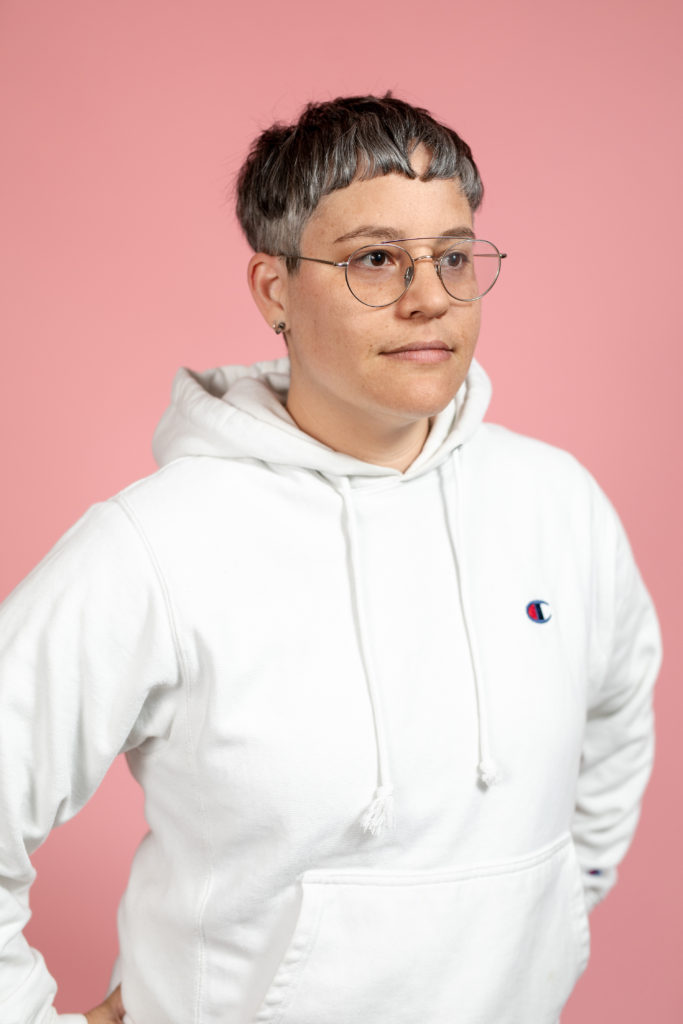Sonia Nicklès rolled up to photographer Lauren Tabak’s house on a $5 skateboard she bought in the Castro, decorated with stickers of gay icons like pro skater Brian Anderson. Soon after Tabak asked her to relay her life story and pose shirtless with her board in the name of LGBTQ+ visibility.
She was one of many invited to shoot with Tabak for her project “Gayface,” a photo series born from a friend’s question of whether or not having a “gay face” or looking queer was significant anymore in a place like San Francisco.
Tabak was curious about how people “flag” or signal to others that they identify as LGBTQ+.
“It’s not about passing. It’s more about flagging,” Tabak said. “It’s about wanting to have community and [to] be seen.” This is especially important, she said, for people who are femme presenting or people who pass as straight.
Tabak said she has been mulling over the concept of identity since writing her college thesis 20 years ago about feminism, fashion and identity politics. She felt this summer was a good time to revisit the idea after a broken arm left her unable to go on the road trip she initially planned.
The outcome: a series of about 30 anecdotes and portraits on a bubble gum pink background, illustrating the many faces of San Francisco’s LGBTQ+ community.
Tabak said she personally “flags” or presents herself as androgynous or in the style of what she calls an LA lesbian, wearing big brimmed hats and a septum ring.
She has lived in the Bay Area for two decades and said her project started out as a way to connect with friends she hadn’t seen in a while. It was also a way to indulge her own curiosity, exploring what it means to be queer in 2019.
Nicklès, an SF State alumna who studied art and sexuality studies, said the personal exploration with Tabak was daunting at first.
“I guess I really struggled with how do I neatly summarize navigating my queer identity because it’s been such an arduous complicated thing,” Nicklès said.
Nicklès said she tried to hide her bisexuality when she was younger and now that she embraces it, she worries that she might not be queer enough.
“Uncertainty is a consistent theme of the bisexual experience,” Nicklès wrote in her picture’s accompanying description on Instagram. “Feeling uncomfortable with straight culture and feeling alienated by queer spaces is also a common thing; it’s been difficult to shake off.”
She said she is currently dating a woman but in the past she dated cisgender male partners and sometimes feels the need to prove herself among the hierarchy of “gold star lesbians.”
As for her appearance, Nicklès said she has gayface just by existing as a queer person, but adds that flagging is important in letting the rest of the community know she is bisexual.
“People tell me that I seem gay becasue I have this sort of like deep flat voice, I have vascular arms, muscular thighs,” Nicklès said.“I guess like having this shitty partially shaved haircut is kind of a way to flag.”
SF State alumnus Kyle Crier, who participated in the photo series, had a different perspective. He said he wasn’t aware that flagging was even a term in the community and doesn’t think one’s outward appearance should be a hot or controversial topic.

“I’ve always been someone who just does what they want to do in regard to style,” Crier said. “When it comes down to it, and when I have always thought about how I got dressed, I didn’t think about how that was going to be perceived by another person.”
Nevertheless, Crier said he found the project exciting and creative direction Tabak provided during the photo shoot.
“It was a very provocative talk. To the point that it was something that I had never even thought about myself, describing what it was like to be bisexual,” Crier said. “I felt like having some way to think about that and having some way to articulate it would be beneficial.”
For Tabak, it was also a learning experience that challenged her own assumptions.
“In particular, there was someone who I didn’t know but I had seen around at a company I work at. And I just assumed he was just a cis guy, I didn’t even know if he was straight or gay,” Tabak said. Then a man, identified in her series as Miles, called her showing his interest in the project. He revealed he was a trans person who started his transition at age four. “I was like ‘wow, okay,’ I feel like I have a pretty good gaydar,” Tabak said. “That was kind of a moment that caught me off guard.”
In the statement he wrote for Tabak’s series, Miles said he hid the fact he was transgender well and ignoring his own identity was isolating.
“Because of that internalized shame it’s taken me a long time to be comfortable publicly identifying, even within an LGBTQ+ space,” Miles said his statement. “Now that I have though, I’ve realized what a pleasure it is to be seen for your whole self.”
Crier said the way society is progressing, people are starting to realize that diversity exists even in distinct groups like the LGBTQ+ community.
“Being visible in a space that was maybe not so queer before I think is going to be important for us going forward,” Crier said. “Again, art is art, it inspires people. I think this is something in the art community and just as people should be celebrated and should be out for others to see.”
Tabak’s work will be featured Sept. 21 at the Dreamers and Make Believers Salon. The opening reception will take place from 7-9 p.m.








